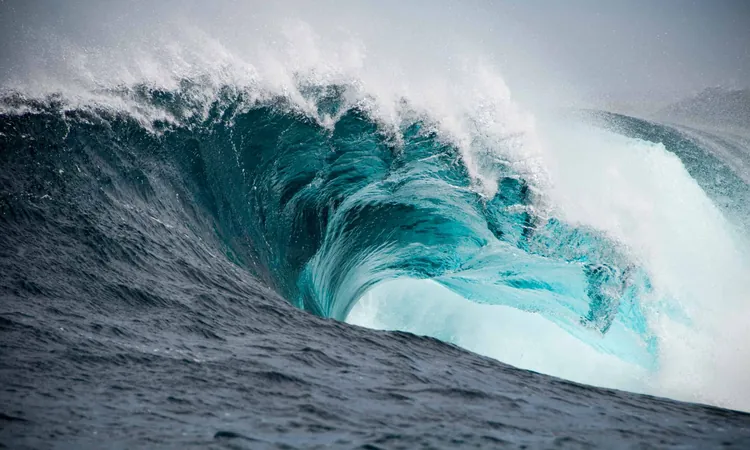
The Shocking Link Between Earth's Sea Level Changes and Ancient Tectonics
2025-04-26
Author: Sarah
Ancient Sea Level Swings: A Hidden History
Did you know that Earth's oceans have not always been on the rise? In a groundbreaking study, scientists reveal a fascinating period when sea levels plummeted by an astonishing 85 to 105 feet! This dramatic shift occurred between 15 million and 6 million years ago, tied directly to changes in seafloor spreading.
The Dynamic Dance of Earth's Crust
Earth isn't just a still ball of rock; it's a constantly moving entity. Spreading ridges create fresh crust, while older crust sinks back into the Earth at subduction zones, keeping our continents and oceans in a state of flux. Interestingly, a recent study found that even a modest 35% reduction in crust production can lead to significant drops in sea levels.
How Ocean Depths Are Altered
You might not think of the ocean floor as a dynamic surface, but it's actually undergoing profound changes. The basaltic crust beneath our seas cools and sinks as it ages. When new crust forms more slowly, this can lead to a noticeable decrease in ocean depths.
The Ripple Effect of Slower Production
Just like an assembly line, the speed at which crust is produced matters greatly. Shifts in this speed can create ripple effects that alter coastlines and even ocean chemistry over millions of years.
When Chemistry Goes Awry
Younger crust interacts readily with seawater, creating vital hydrothermal systems. If the crust formation slows, this vital heat exchange diminishes, resulting in shifts in oceanic chemistry.
A Stark Contrast with Modern Ice Melt
Think about this: If today’s East Antarctic Ice Sheet were to melt entirely, ocean levels might rise by about 118 feet! How does this compare to ancient times when seas dramatically retreated instead of creeping upwards? The implications are enormous for coastal ecosystems.
Tectonic Impact on Climate Discussions
Conversations about rising sea levels often center on climate change, but geology plays a crucial, yet subtle role. While modern ice melts happen relatively quickly, tectonic changes occur at a slower pace but yield lasting effects.
Tracking the Geological Clues
By examining rocks along coastlines, scientists can unveil hidden histories of ancient shorelines. These findings, paired with reconstructions of plate movements, offer a clearer picture of our planet's geologic evolution.
Heat Flow and Ecosystem Health
As younger crust becomes scarcer, the overall heat flow from Earth's mantle decreases. This drop, estimated at around 8%, impacts not only Earth's cooling history but also affects deep-sea ecosystems near hydrothermal vents.
The Bigger Picture
Recent studies underline that tectonic changes can rival the effects of ice melt on sea levels. This perspective is crucial, showing that climate should not be viewed as the sole driver of oceanic shifts.
Implications for Our Future
Understanding these tectonic processes is vital, especially considering that today's coastlines are shaped not just by melting ice but also by slow, powerful geological movements. As researchers refine their models, they aim to predict future sea-level changes more accurately.
A Call to Awareness
Every slight change in ocean levels impacts coastal communities. Recognizing that deep Earth processes play a significant role expands our appreciation for how geology and climate change work hand-in-hand.
Final Thoughts
This pioneering research connecting slower crust production to ancient sea-level drops invites intriguing questions about our planet's internal mechanics. As scientists continue to explore, one thing remains clear: Earth’s interior has been a crucial player in shaping the heights of our seas throughout history.
The study can be found in the latest publication of *Geochemistry, Geophysics, Geosystems*.


 Brasil (PT)
Brasil (PT)
 Canada (EN)
Canada (EN)
 Chile (ES)
Chile (ES)
 Česko (CS)
Česko (CS)
 대한민국 (KO)
대한민국 (KO)
 España (ES)
España (ES)
 France (FR)
France (FR)
 Hong Kong (EN)
Hong Kong (EN)
 Italia (IT)
Italia (IT)
 日本 (JA)
日本 (JA)
 Magyarország (HU)
Magyarország (HU)
 Norge (NO)
Norge (NO)
 Polska (PL)
Polska (PL)
 Schweiz (DE)
Schweiz (DE)
 Singapore (EN)
Singapore (EN)
 Sverige (SV)
Sverige (SV)
 Suomi (FI)
Suomi (FI)
 Türkiye (TR)
Türkiye (TR)
 الإمارات العربية المتحدة (AR)
الإمارات العربية المتحدة (AR)